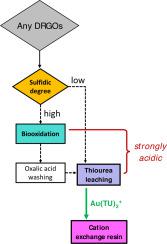当前位置:
X-MOL 学术
›
Hydrometallurgy
›
论文详情
Our official English website, www.x-mol.net, welcomes your
feedback! (Note: you will need to create a separate account there.)
Complete gold extraction and recovery from double refractory gold ores by thiourea after bio-oxidation
Hydrometallurgy ( IF 4.8 ) Pub Date : 2024-05-17 , DOI: 10.1016/j.hydromet.2024.106330 Keiko Sasaki , Ikumi Suyama , Ryusei Takimoto , Kojo Twum Konadu , Hirofumi Ichinose , Jacques Eksteen
Hydrometallurgy ( IF 4.8 ) Pub Date : 2024-05-17 , DOI: 10.1016/j.hydromet.2024.106330 Keiko Sasaki , Ikumi Suyama , Ryusei Takimoto , Kojo Twum Konadu , Hirofumi Ichinose , Jacques Eksteen

|
Cyanidation, a conventional process to extract gold from gold ores, has been used for over 130 years in industrial mining because of the high efficiency and rate of formation of Au(CN) and the high recovery efficiency by adsorption of Au(CN) on activated carbon. However, carbonaceous refractory gold ores are not targeted because Au(CN) is easily adsorbed on carbonaceous matter in the ores, resulting in high recovery loss. In this study, the flotation concentrates of a carbonaceous refractory gold ores was subjected to biooxidation at 45 °C using a mixed culture containing iron-oxidizing and sulfur-oxidizing bacteria, followed by gold extraction using thiourea under strongly acidic conditions. The gold extraction efficiency reached ∼100% in 12 h without re-adsorption. Finally, the quantitative recovery of the Au(CS(NH)) complex was confirmed by adsorption on strongly cationic exchange resin. Biooxidation reduced the amount of Fe-containing metal sulfides, which minimized the decomposition of thiourea, and the Au(CS(NH)) complex had a low affinity toward carbonaceous matter, different to Au(CN). Since the process described in this study does not require roasting to remove carbonaceous materials in pretreatment and does not use cyanide for gold extraction, it is environmentally friendly and should be considered for practical applications in carbonaceous gold ore-producing mines.
中文翻译:

双难熔金矿生物氧化后硫脲完全提金回收
氰化法是从金矿石中提取金的传统工艺,由于 Au(CN) 的形成效率和速率高,以及通过活性炭吸附 Au(CN) 的回收效率高,已在工业采矿中使用了 130 多年。碳。然而,碳质难熔金矿石不作为目标,因为Au(CN)很容易吸附在矿石中的碳质上,导致回收损失较高。在这项研究中,使用含有铁氧化和硫氧化细菌的混合培养物在 45°C 下对碳质难熔金矿石的浮选精矿进行生物氧化,然后在强酸性条件下使用硫脲提取金。金提取效率在 12 小时内达到~100%,无需再吸附。最后,通过强阳离子交换树脂的吸附证实了Au(CS(NH))络合物的定量回收。生物氧化减少了含铁金属硫化物的量,从而最大限度地减少了硫脲的分解,并且与Au(CN)不同,Au(CS(NH))络合物对碳质物质的亲和力较低。由于本研究描述的工艺在预处理中不需要焙烧去除碳质材料,并且不使用氰化物提取金,因此对环境友好,应该考虑在碳质金矿石生产矿山中实际应用。
更新日期:2024-05-17
中文翻译:

双难熔金矿生物氧化后硫脲完全提金回收
氰化法是从金矿石中提取金的传统工艺,由于 Au(CN) 的形成效率和速率高,以及通过活性炭吸附 Au(CN) 的回收效率高,已在工业采矿中使用了 130 多年。碳。然而,碳质难熔金矿石不作为目标,因为Au(CN)很容易吸附在矿石中的碳质上,导致回收损失较高。在这项研究中,使用含有铁氧化和硫氧化细菌的混合培养物在 45°C 下对碳质难熔金矿石的浮选精矿进行生物氧化,然后在强酸性条件下使用硫脲提取金。金提取效率在 12 小时内达到~100%,无需再吸附。最后,通过强阳离子交换树脂的吸附证实了Au(CS(NH))络合物的定量回收。生物氧化减少了含铁金属硫化物的量,从而最大限度地减少了硫脲的分解,并且与Au(CN)不同,Au(CS(NH))络合物对碳质物质的亲和力较低。由于本研究描述的工艺在预处理中不需要焙烧去除碳质材料,并且不使用氰化物提取金,因此对环境友好,应该考虑在碳质金矿石生产矿山中实际应用。


















































 京公网安备 11010802027423号
京公网安备 11010802027423号